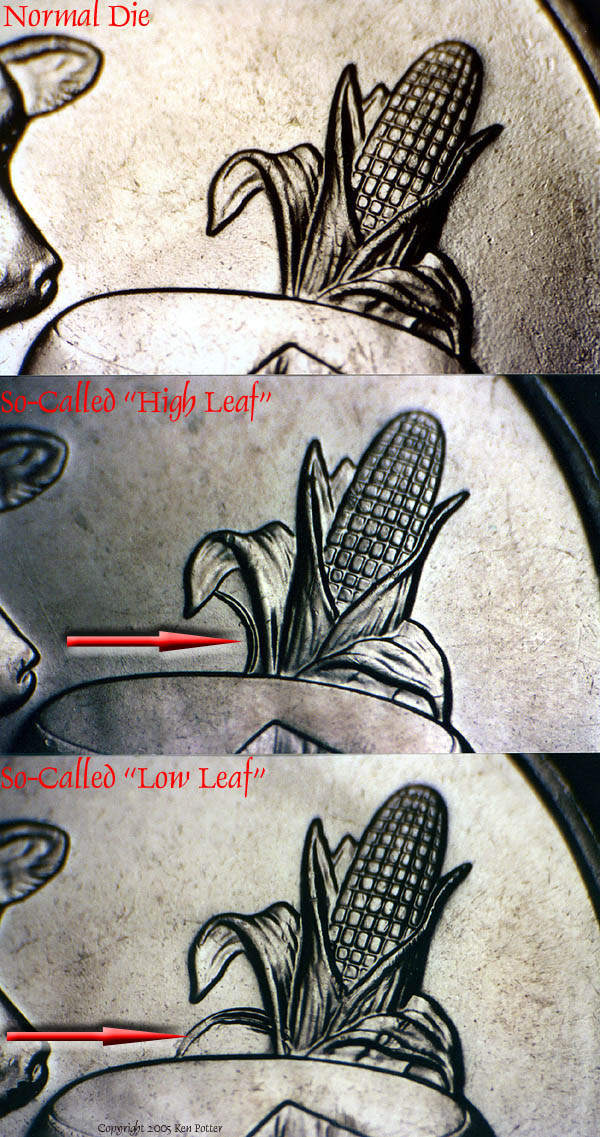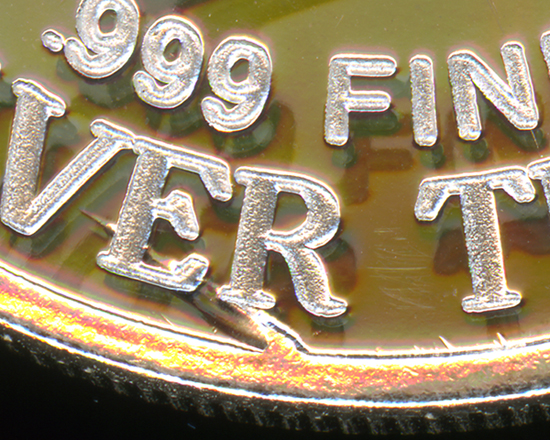
Ken Potter's Educational Series ...
![]()

![]()
Ken Potter's Educational Series
...
![]()
Analysis Of The 2004-D Wisconsin Quarters
With Die Gouges
by Ken Potter, NLG
February 13, 2005
Revised March 8, 2005

Top Photo:
This is the normal version of the 2004-D Wisconsin quarter.
Middle Photo: This is the so-called High Leaf.
It is actually die damage nonsensically "growing" from out of the circle
of cheese below and ending abruptly at the tip of a leaf from the corn.
Lower Photo: This is the so-called "Low Leaf" that pierces right through a
normal leaf
in a most unnatural fashion and then arcs down into the wheel of cheese
below.
I've been following the posts on Rec.collecting.coins on the new 2004-D Wisconsin die damage error or variety quarters (call them what you want, error or variety makes little difference), and I agree with Tom DeLorey's earlier comments 100% (his comments are copied at the end of this post). I received a set a couple of days ago from Bill Fivaz for examination and they confirmed my worst fears. The coins represent nothing but trivial die gouges (or possibly the closely related die dent type of die damage).
They are prominent -- more so than average -- but they are NOT "extra leaves" by any stretch of the imagination. They are die gouges (or again, possibly die dents) with an estimated value of no more than $10 each by standards usually attached to such items. This value assumes that coins would have been promoted as what they are but as we can see they have not and as such we have seen what is generally considered a relatively minor flaw promoted up to being worth hundreds of dollars by using misleading nicknames.
With all due respect to the opinions of those who are convinced these are intentional die varieties, as far as I'm concerned, the images provided by both Coin World and later by J.T. Stanton, (to several specialists in an earlier private thread), and a look at the actual coins, proves beyond any reasonable doubt in my mind that these are not intentional die varieties but are instead some sort of die damage such as die dents or gouges. I did not need to see the coins to know this as the images referenced above were excellent but I decided to wait until I saw the actual coins before commenting publicly.
First, it is my opinion that the States quarters program is one that must move quickly and without much revision after a design is approved and a sculpt made so that they can begin work on the next quarter. These designs are in use today and gone (from the Mint's agenda) tomorrow.
There is little reason to tinker with designs to constantly improve their character as might be the case on long-lived designs such as the Lincoln cent obverse where improved designs can effect die life, aesthetic appeal, etc, for decades. Once a sculpt is approved and an epoxy made from which a master is created, there is very little likelihood for the Mint to tinker with the designs. If you break a master you simply make another from the same epoxy as the first. Breaking a master has to be fairly rare and breaking two in a row has to be about as rare as hen's teeth. Still, a second or third master from an epoxy should be the same as the first.
Further, a look at the so-called extra leaves shows that they fall short of exhibiting characteristics of an intended design.
On the so-called "high leaf" we see that its base starts "sprouting" from a chunk of cheese! It is not connected to the ear of corn at all until its apex ends abruptly at a leaf from the corn stalk (stalk unseen below and behind the cheese). Folks, mold grows on cheese but not corn leaves! Additionally good sculptors (or engravers) do no cause designs to end abruptly like this. They encourage the overlapping of designs to create depth -- it is one the basics a good sculptor/engraver works into his/her designs instinctively (or so I am told by those who have cut dies for me).
In this case, if that so-called extra leaf was intended, it would have had its base start within the corn (not from a chunk of cheese) and it would have tapered to a point that overlapped slightly over the larger leaf above or ended earlier. It would not end abruptly and awkwardly at the leaf unless its tip was bent over to the side (which would have also been an option available to the engraver to give it a natural feel -- but we do not see that here either).
On the so-called low leaf what we see is a crescent shaped doubled curve with its base starting within the central area of the lower corn which then skips the high points of the larger leaf and reappears outside to continue its curve until it ends at the cheese. Corn leaves do not grow right through the center of other leaves (like an arrow shot through the leaf). If this was a deliberate design the so-called extra leaf would have been coming out from under that main leaf or would have been overlapping -- not created as a composite that shows it piercing through in such an unnatural fashion.
Additionally, neither of the so-called extra leaves has any contoured flatness or texture. The high variety is simply a tall narrow gouge while the high variety is two narrow gouges (as if from a piece of jagged tooling) with too quick of a taper. This one also shows an area of incuse field running directly below the majority of the doubled area of the alleged doubled leaf suggesting metal displacement due to damage to the die from impact after the die was made.
We often see these types of depressions in the field around Mint marks from the era of when they were punched into the individual dies prior to the 1990s (which again, is metal displacement from impact). The fact is, the positions of these so-called leaves are just too random and awkward to be deliberate design modifications. They lack the contoured flatness and leafy texturing of the legitimate leaves. Simply put, they don't look like they fit into the design because they don't.
They are certainly not the way a U.S. Mint engraver would design a coin much less even a second-rate engraver of silver rounds just start starting out.
To take a closer look, the reason the low leaf appears to be skipping the high points is because it is a gouge or dent that did not sink far enough to obliterate the original design. This is most damaging to the "deliberate design" theory since we know how these effects occur and we know that designers do not design coins that way. The effect tells us all we need to know. Die gouges, scratches, etc., skipping over lower areas of the die (relief areas of design on the coin) are a well-known diagnostic associated with die gouges, etc.
To illustrate this point further, I pulled a silver round I had struck from a damaged die a few weeks ago with a large die gouge running through the field and over some letters. The die was damaged extensively with many scratches and a scattering of gouges from being mishandled. It had been mistakenly thrown into a bin of retired dies with closed out designs where it was allowed to bounce around and be hit by the other dies which had unprotected faces (no die caps). I sent it in anyway to be polished in an attempt to refresh it and had some sample rounds struck..
On the 25 sample rounds I had struck from this die it could be seen that most of the scratches and smaller gouges were removed but the largest gouge remained.

As you can see, the gouge is large -- as large as those on the Wisconsin quarters -- and it skips over the letters. As gouges (or dents) often go, it also has a sort of leafy shape to it too!
As to these (Wisconsin quarters) showing deliberately placed gouges, (another suggestion that has been advanced), it is my opinion that a gouge is a gouge is a gouge (or a dent is a dent ...). How it got there matters little. Minor is minor no matter how it is presented. Second, there is not a shred of evidence that suggests they got there through some deliberate action. Die gouges (or dents) are common on coins and like finding angels in the clouds, you will find them where you want if you look long enough. Coincidental? Perhaps. But, in the face of there being no proof they were intentionally placed there, I have to ask -- so what?
I wonder? Are we now going to catalog every "conveniently" placed gouge, die break or dent that comes along? If so, it is retroactive? At what point (and who decides) which dents or gouges are major and which are minor? If this is where we are heading, the Spadone book should become a best seller overnight!
Or will we segregate the importance of gouges, dents and breaks by the era in which a coin was made? I for one do not welcome a return to the days of marketing minor flaws under fancy names that have nothing to do with what they actually are -- especially when the fancy names mask a minor flaw and make it sound far more important than it really is. These are minor flaws with catchy nicknames -- and nothing more.
We have plenty of RPM, doubled dies, cuds, legitimate design modifications, etc., still being discovered in quantities large enough to keep all the attributers and collectors busy without bringing in the minor flaws don't we?
I'd suggest we do not open the floodgates to the abuses of the past but it now looks like it is too late!
I want to make clear that I am under no illusion that these coins are most probably here to stay. There are too many major players that have gotten behind these coins that will continue to push them as something that they are not for a long enough period to make them stick. It appears this is one of those rare examples of a trivial error type being promoted into familiarity and acceptance by the big promoters. Very few minor errors given fancy nicknames ever stick but a few do catch on. In a nutshell, what I am against is the promotion of such items under misleading nicknames. I wonder how well these coins would have sold if they were labeled as what they are rather than with a nickname that suggests they are much more?
Ken Potter, NLG
www.koinpro.com
![]()
Tom DeLorey wrote:
You forgot the 1944-D half, where somebody accidentally polished the designer's monogram off of the reverse die and then hand cut it back into the die. THAT is a cool variety. These Wisconsin quarters are just, in my opinion, random die damage that occurred near the corn by coincidence. Remember the 1890-CC Morgan with the die gouge at the tailfeathers? Somebody heavily promoted it back in the late '60s and early '70s as the "TAILBAR VARIETY! EXTRA TAIL FEATHER!" at big premiums. The last one I had in stock, I priced $10 over a regular coin of the same grade, and it took about a month to sell.
Tom DeLorey



Numismatist Since 1959 ~ Serving
the Collector Since 1973
CONECA's Longest Serving Doubled Die Attributer
Member of: ANA CONECA-LM NLG NCADD-FM
MSNS-LM
NWDCC RCC COINMASTERS LCS WBCC BBCC

Free counters provided by Andale.